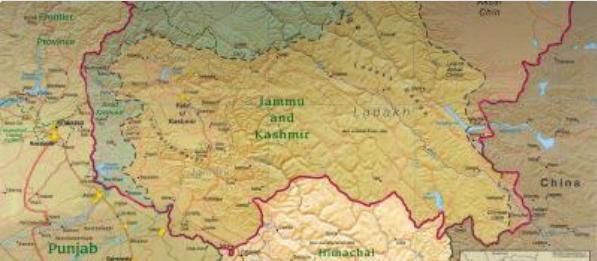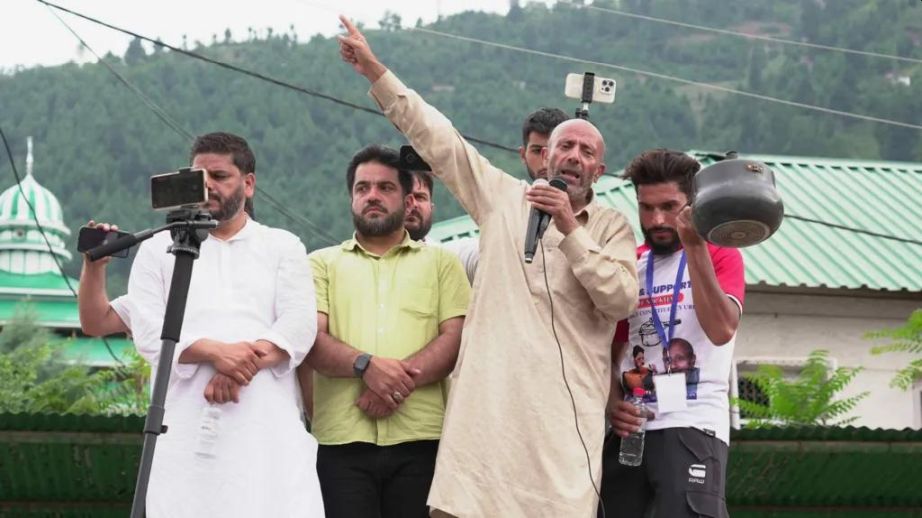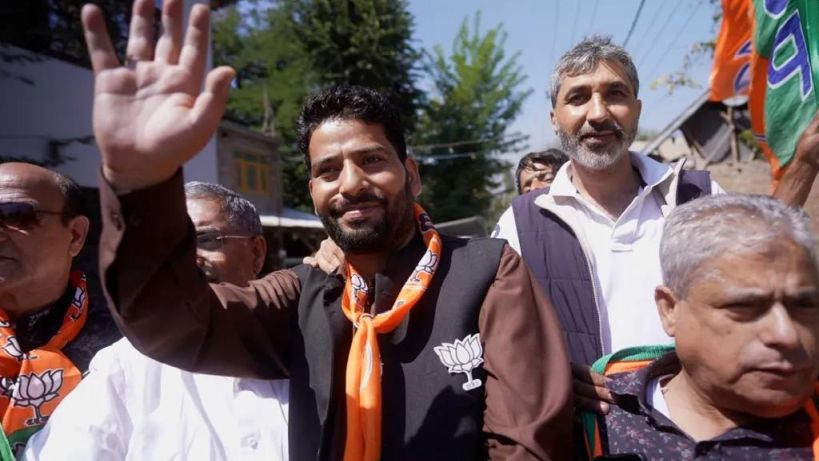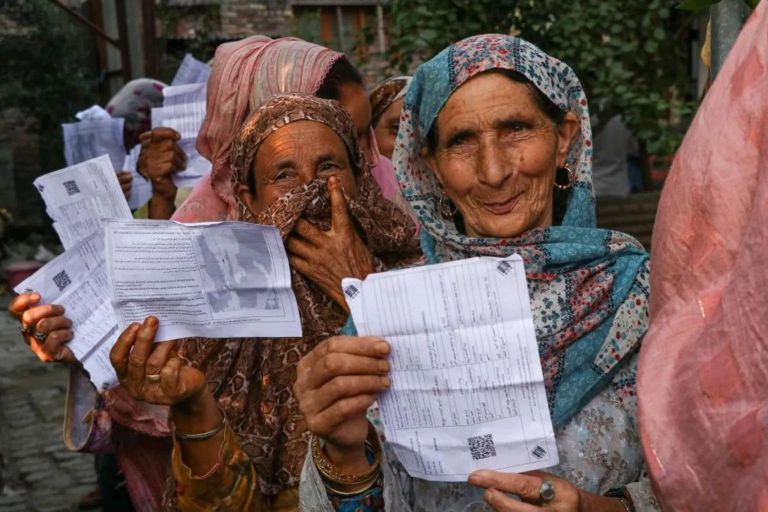By Eric Vandenbroeck and co-workers
The Ongoing Dilemma of Jammu and
Kashmir
On Nov. 3, at least
11 shoppers were injured in a grenade attack on a flea market in Srinagar, the summer capital
of the Indian union territory of Jammu and Kashmir. One woman later died from
her injuries. It was just the latest terrorist incident since a new government took office in mid-October. In Jammu, the
predominantly Hindu part of the territory, terrorist attacks have killed at
least 44 people this year, including 18 security personnel.
This territorial
conflict over the Kashmir region, primarily between India and Pakistan, and also between China and India in the northeastern portion
of the region. It is a dispute over the region that escalated into three wars
between India and Pakistan and several other armed skirmishes. India controls
approximately 55% of the land area of the region that includes Jammu, the
Kashmir Valley, most of Ladakh, the Siachen Glacier, and 70% of its population;
Pakistan controls approximately 30% of the land area that includes Azad Kashmir
and Gilgit-Baltistan; and China controls the remaining 15% of the land area
that includes the Aksai Chin region, the mostly uninhabited Trans-Karakoram
Tract, and part of the Demchok sector.
It is generally accepted that Kashmir is a victim of
the disputed division of British India during the transfer of colonial power in
1947. A border was created on religious lines, and states with a Muslim
majority formed the newly created Pakistan alongside a predominantly Hindu
India. When India and Pakistan became independent, it was generally assumed
that Jammu and Kashmir, with its 80 percent Muslim population, would accede to
Pakistan, but Kashmir was one of 565 princely states whose rulers had given their
loyalty to Britain but preserved their royal titles. The partition plan, negotiated by the last viceroy, Lord Mountbatten,
excluded these princely states, which were granted independence without the
power to express it.
Initially, the
British created the state of Jammu and Kashmir from a disparate group of
territories shorn from the Sikh kingdom placing it under the rule of a
Dogra raja, and during the late nineteenth century, they directly intervened in
the administration of the state. The consequent land settlement of the region
led to the breakdown of the state monopoly on grain distribution, the emergence
of a class of grain dealers, the creation of a recognizable peasant class, and
the decline of the indigenous landed elite. Additionally, the slump in the
shawl trade beginning in the 1870s meant that shawl traders were in a state of
financial and social decline by the late nineteenth century. At the same time,
the Dogra state became more interventionist, and centralized, and the
"Hindu" idiom of its rule became increasingly apparent.
But contrary to popular belief, it was
not the isolation of the Kashmir Valley that produced narratives of regional
and religious belonging; rather, it was the Valley's links with the world
outside that helped reinforce the poetic discourse on identities in the
mid-eighteenth to early-nineteenth centuries.

Rather, the axiom of Kashmir as the
paradise on earth, which even then belied the reality of the condition of the
Valley and its inhabitants, was coined by the Mughal emperor Jehangir.1
The 1947 Partition created two newly
independent states - India and Pakistan - and triggered perhaps the most
significant movement of people in history, outside war and famine. About 12
million people became refugees. Between half a million and a million people
were killed in religious violence and rhetoric that continues
today.
The partition of
India in August 1947 was, to a degree, related to British concerns about the
possibility the USSR could acquire influence.
The Situation as It Is Today
The former state of Jammu and Kashmir -
now divided into two federally administered territories - is holding its first assembly election in a decade. The third and last phase of voting is on Tuesday and
results will be declared on 8 October.
Since the 1990s, an
armed separatist insurgency against Indian rule in the region has claimed
thousands of lives, including those of civilians and security
forces. Earlier, elections were marred by violence and boycotts as
separatists saw polls as a means for Delhi to try and legitimize its control.
The high voter turnout now signals a change - people here say they have waited long to be heard.
“The level of poverty
in our area is severe,” says 52-year-old Mohammad Yusuf Ganai after casting his
vote. He laments that the lack of jobs has forced educated young Kashmiris to
"sit at home". The last elections a decade ago resulted in a
coalition government that collapsed in 2018. Before new polls could be held,
Prime Minister Narendra Modi's Bharatiya Janata Party
(BJP) government revoked the
region's autonomy and
statehood, sparking widespread discontent among Kashmiris.
For five years, Jammu
and Kashmir has been under federal control with no local
representation, and this election offers people a long-awaited chance to voice
their concerns.
“We will finally be
able to go to the elected official with our problems,” says 65-year-old
Mohammad Abdul Dar.

BJP candidate Engineer Aijaz Hussain (centre) says people in Kashmir have faith in the election
process now
One argument offered
by Indian security officials holds that the powerful Pakistani security
establishment, which has never reconciled itself to Indian rule in any part of
Kashmir, has ramped up its support for
terrorist actions.
Islamabad may seek to convey a message that it can undermine newly elected
Jammu and Kashmir Chief Minister Omar Abdullah. He is the vice president of the
regional National Conference, the party with the longest lineage in Kashmir,
and the scion of a noted Kashmiri political
family.
Pakistan—and
particularly its security apparatus, which has long controlled policies on the
Kashmir question—has been smarting since Indian Prime Minister Narendra Modi
and the Bharatiya Janata Party (BJP) revoked Article
370. Removing the region’s special autonomous status made good on a
long-standing electoral promise and turned Jammu and Kashmir into a union
territory, bringing it mostly
under the control of the national government.
The BJP hoped that
this would not only undermine Pakistan’s claim to Kashmir but also end
simmering secessionist sentiment in the region as citizens reconciled
themselves to the new status quo. Pakistan vigorously protested the 2019
decision, including at the United Nations, to little avail. Five years later, with an elected
government now in place in Jammu and Kashmir, Islamabad’s security
establishment may have decided that now was the moment to sow discord in the
region once again.
However, some
analysts attribute the resurgence of terrorist violence in Kashmir
to a different source, arguing that the recent uptick may be locally
organized rather than
inspired and abetted by foreign forces. In this view, policies in the territory
after the revocation of Article 370 contributed to popular discontent and
spawned indigenous militancy; the quashing of dissent has fueled resentment
against the high-handed tactics of the Indian state.
BJP candidate Engineer Aijaz Hussain (centre) says people in Kashmir have faith in the election
process now

The BJP government
insists that scrapping the region’s special status and placing it under direct
rule has brought peace and development, with Prime Minister Modi announcing
$700m (£523m) in projects during a visit in March. It’s now up to BJP candidate
Engineer Aijaz Hussain in Srinagar's Lal Chowk to convince voters of this
message.
“Previously, no one
would go door to door [to campaign]. Today, they are. This is our achievement,
isn’t it?” says Aijaz. He points to the increased voter turnout as proof
of faith in the election process, with the recent parliamentary elections seeing
record participation. Yet, despite these claims, the BJP did not contest those
elections and is now only fielding candidates in 19 of the 47 assembly seats in
the Kashmir valley.
The party’s
stronghold remains the Hindu-dominated Jammu region with 43 seats, where it is
hoping to score well. “Our organisation is weak
in other constituencies,” admits Aijaz.
The Hindu nationalist
BJP has been trying to make inroads in the Muslim-majority Kashmir valley,
where it has had little presence.
The Current Violence
A third explanation
attributes the recent spike in terrorist violence to Indian troop
redeployments. The Modi government has moved a substantial number of soldiers
from the Kashmir Valley—the principal locus of terrorist activity in the
region—to the Himalayan front, where India has been engaged in a standoff with China on the countries’ disputed border
since a deadly clash in 2020. The specific number of troops who have been moved
remains classified.
Of course, these
three factors could be at play in Indian-administered Kashmir. Pakistan’s
security and intelligence services may have returned to their support for
terrorism in the region as a new
state-level government was
about to assume office. The inability of this government, which has not been
granted police powers, to contain an upsurge in terrorist activity could
hobble its ability to rule effectively. This could lead to losing popular support
and contribute to political disenchantment and alienation.

Simultaneously, the
administration in Kashmir before this year’s election added to the frustrations
of Kashmiris, especially in the Kashmir Valley, cannot be dismissed. Despite
the Modi government’s trumpeting promises of economic development in the
region, little of it
has occurred.
(Furthermore, a rise in terrorist attacks will certainly challenge this
narrative.) Among other matters, unemployment
remains high,
contributing to Kashmiri youth discontent.
The unhappiness of
Kashmir Valley residents was palpable in the aftermath of the abrogation of Article 370. An Indian
Supreme Court judgment last December to uphold the 2019 decision did little to
assuage Kashmiri Muslims and heightened
fears about an
erosion of their rights. In August, reputed analyst Radha Kumar told the Diplomat that a sense of
“alienation” from the Indian state had deepened in the region since 2019. For
the most part, this year’s election at least gave Kashmiris an outlet to
express their political sentiments; they now have high expectations of
their new government.
Asserting an
unequivocal causal link between the disenchantment of Muslim Kashmiris and the
return of terrorist activity to the region may be difficult. However, this
sense of hopelessness among a significant segment of Kashmir’s population may
have contributed to the return of extremist violence.

While regional
political parties promise change and say they are fighting for the rights of
Kashmiris, how much influence will they have after these elections? Lawyer
Zafar Shah anticipates friction between the federal administration and the
elected government which will soon assume charge.
Before 2019, when
Jammu and Kashmir was a state, the chief minister
could enact laws with the consent of the governor, who was bound by the state
cabinet’s recommendations.
Now, as a federal
territory under a Lieutenant Governor (LG), the chief minister must get the
LG's approval, especially on sensitive issues like public order, appointments
and prosecutions. Power has shifted, says Mr Shah, as
the LG won’t act without clearance from the federal home ministry.
“Whether the LG can
create hurdles in the government’s working, that’s a matter to be seen when an
actual situation arises,” adds Mr Shah. Despite the
challenges, many in Kashmir hope these elections will give them a chance to
finally have their own representatives to voice their concerns.
1. See also G.M.D.
Sufi, Kashir: Being a History of Kashmir From
Earliest Times to Our Own. 2 vols. New Delhi, 1974, vol. i, p. 295.)
For updates click hompage here